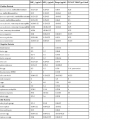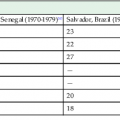Mary T. Caserta
Acute Laryngitis
Acute laryngitis is a clinical syndrome commonly encountered by primary care physicians. The symptoms are often described as the recent onset of hoarseness or a husky voice with decreased voice projection often associated with a dry cough.1 There may be voice breaks or episodes of aphonia that frequently occur in the context of an upper respiratory tract infection with rhinorrhea and sore throat. The duration of symptoms is difficult to discern from the literature; however, in a study of 80 adults with the common cold, hoarseness was reported for a median of 3 days, and 5.5 days represented the 75th percentile.2 Although most reports describe acute laryngitis as a mild and self-limited syndrome, a survey of intercollegiate athletes found substantial morbidity associated with laryngitis.3 These students reported laryngitis significantly more often as a cause of missed practice, compared with cough, nasal discharge, or myalgia, and as having an adverse effect on their athletic performance.
The incidence of acute laryngitis reported in the literature varies and is highly dependent on the research methods used. A study utilizing a large medical claims database found that approximately 1% of people presenting for care did so because of dysphonia, with 42% receiving a diagnosis of acute laryngitis.4 In reports including almost 5000 children and adults with acute respiratory symptoms, 2% were given a primary diagnosis of laryngitis.5,6 In other studies, 38% of patients with pneumonia reported hoarseness as a symptom, as did 53% of adults with colds and 67% of children with bacterial tracheitis.2,7,8 Laryngitis has also been noted in approximately 22% of adolescents or school-aged children with nonstreptococcal sore throat.9 Despite this demonstration that laryngitis affects patients of all ages, a report of more than 800 patients seen in an ear, nose, and throat clinic showed that most patients with acute laryngitis presenting for care were women with a mean age of 36 years.10 In addition, the study showed that the frequency of laryngitis during the colder months was almost double that observed in the warmer seasons.
All of the major respiratory viruses have been etiologically associated with laryngitis. In the study of patients older than 5 years of age with a primary diagnosis of laryngitis, 21% had infection with parainfluenza virus, 15% had rhinovirus, 3% had influenza virus, and 3% had adenovirus.5 The risk of developing laryngitis with a particular type of respiratory tract infection is summarized in Table 60-1. McMillan and colleagues9 reported that laryngitis and cough were noted significantly more often among patients with influenza (29%) than among patients with group A β-hemolytic streptococcal infection (2.3%). In a retrospective review of an epidemic of influenza in the United Kingdom, the rate of laryngitis or tracheitis reported by general practitioners peaked at approximately 100 per 100,000 population, coincident with the peak of influenza illness.11 Younger patients were significantly more likely to report hoarseness than elderly subjects in a study of human metapneumovirus infection.12 Hoarseness was reported in 91% of young adults with human metapneumovirus infection compared with 42% of similar-age subjects with respiratory syncytial virus infection. Acute laryngitis was the primary diagnosis in 3.3% of children from 1 month to 14 years of age hospitalized with acute respiratory symptoms and infection with human metapneumovirus.6 Among older adults admitted to the hospital for respiratory disorders, hoarseness was reported by 25% of subjects with illness resulting from rhinovirus or coronavirus.13 Hoarseness or laryngitis has not been reported as a symptom in patients with severe acute respiratory syndrome secondary to human pneumonia–associated coronavirus.14
TABLE 60-1
Frequency of Laryngitis Associated with Common Respiratory Pathogens
| PATHOGEN | FREQUENCY (%) | REFERENCES |
| Rhinovirus | 25-29 | 13, 34 |
| Influenza | 28-35 | 9, 13, 34 |
| Parainfluenza | 8.5 | 35 |
| Adenovirus | 22-35 | 36 |
| Coronavirus | 25 | 13 |
| Mycoplasma pneumoniae | 3-37 | 7, 13 |
| Chlamydia pneumoniae | 30 | 37 |
| Group A β-hemolytic streptococcus | 2.3-19 | 9, 34 |
| Human metapneumovirus | 3-91 | 6, 12, 38 |
Stay updated, free articles. Join our Telegram channel

Full access? Get Clinical Tree








